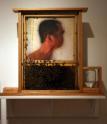Fragile life, artistic endeavors
For most, a sight of a bee triggers anxiety and a flight response. For Brigham Dimick, the insect triggers art.
Dimick, area head of drawing at SIUE, is displaying some of his artwork currently at the University of Missouri St. Louis’ (UMSL) Gallery 210. Most of the art involves a concept drawn and built up by Dimick. The rest of the art is done by honeybees doing what they do best: building honeycombs.
This sort of relationship with stinging insects can be dangerous, especially because Dimick is severely allergic to honeybee stings. However, working with bees is the best choice because he’s even more allergic to wasps, hornets and others.
“I do not have a death wish so I work with bees,” he said. “However, I also work with bees to direct attention to their own vulnerabilities. Over the past 10 years, there has been a rising concern about the waning populations of honeybees due to colony collapse disorder. My work seeks to point attention to plight of the bees, and, in general, our symbiotic relationship.”
Dimick said many artists also pull creativity from their own traumatic experiences to enable their artwork, another reason he works with bees. Eight years ago, Dimick went into anaphylactic shock within 10 minutes after two wasp stings to his hand. His wife returned just in time to inject him with epinephrine and most likely saved his life.
Since then, Dimick has had two more episodes in his allergist’s office after being injected with hymenoptera venom, which in small doses is intended to slowly build up antibodies to lessen the danger of future stings.
“These experiences help one to consider one’s mortality more frankly, and serve as sources for re-imagining the creation of images,” he said. “These experiences, though frightening, have been valuable to me in locating specific metaphors about process and material in relation to self-portraiture.”
Dimick creates his art by casting his head and neck and body in plaster, and using plastic around the negative space in which the bees build their honeycomb. The result is a visual synergy between human creativity and nature.
“It is quite exciting to simply set a process in motion and observe how nature responds in very surprising ways,” he said. “More to the point, it is important to me that art is an instrument that helps us reflect on our interdependency with nature.”
Gallery 210 at UMSL will be featuring Dimick’s creations along with artwork by Greg Edmondson and Ronald Leax until October 1, 2011. The gallery explores the dimensions of art when crossed with science.
Page 1 of 3 | Next page

